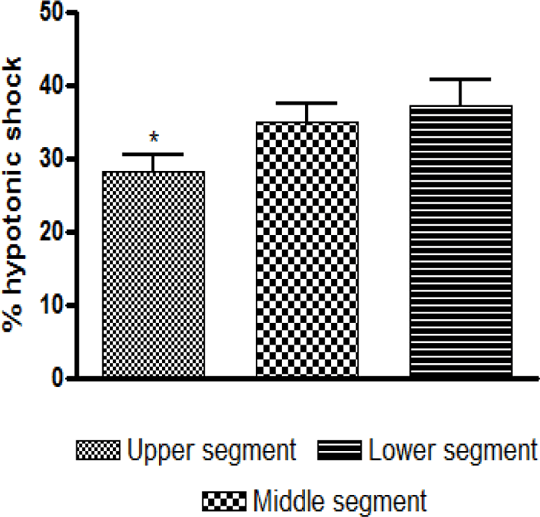Topographical differences in myogenicity and functional EP receptors in isolated rat uterus during late gestation. Prostaglandin E2 (PGE2) mediates uterine responses by binding to its four receptor subtypes EP1–4; however regional differences in the functional receptors during gestation are not fully explored. The aim of this study was to determine myogenicity and responsiveness to PGE2 and EP1-4 receptor agonists in the rat uterine horn at late gestation. Timed pregnant Lister Hooded rats were sacrificed on day 18 of gestation (n = 5-6). Uterine horns were opened longitudinally, cleared of foetuses and placentae and divided into three segments (upper (ovarian end), middle and lower (cervical end)). Tissue from each segment was immersed in organ baths containing Krebs’ buffer at 37°C, pH 7.4 with 1µM indometacin, gassed with 95%O2/CO2 and attached to isometric force transducers (Hutchinson et al., 2003). After 30 minutes equilibration, intrinsic activity was recorded, followed by cumulative concentration-effect curves with compounds added at 10 minute intervals (10-9M to 10-5M) for PGE2, sulprostone, (EP1/3 agonist; Schaaf et al., 1981), ONO-D1-004, (EP1 agonist; Oka et al., 2003), butaprost, (EP2 agonist; Gardiner, 1986) and L-902688,(EP4 agonist; Billot et al., 2003). Agonists were prepared in ethanol apart from L-902688 which was dissolved in dimethyl sulfoxide before dilution in normal saline solution (0.9% w/v). Data were recorded as area under the curve and expressed as a percentage of the reference contraction (hypotonic shock) (Fischer et al., 2008). Results were expressed as arithmetic means ± SEM and statistically analysed using one and two-way ANOVA with Bonferroni’s post-hoc test. Spontaneous activity of the uterine segments was greater in lower segment samples (p<0.05; Figure 1) compared with samples from the upper segment. PGE2 enhanced activity in all three segments; this was significantly greater in the mid section at 10-6M compared to upper and lower segments (p<0.05). Sulprostone increased contractility in upper (p<0.01) and middle (p<0.001) segments compared to the lower uterus at 10-5M. Butaprost attenuated myogenicity in a concentration-dependent manner in all regions. Both ONO-D1-004 and L-902688 did not evoke significant changes in contractility along the length of the horn.

Figure 1: Spontaneous activity of rat uterine tissue, taken from upper, middle and lower segments at late gestation. *p<0.05 reduction in contractility compared to lower segment tissue. The results show that the spontaneous activity of the rat uterus during late gestation increases from the fundus towards the cervix. Although ONO-D1-004 and L-902688 did not affect uterine responses, significant regional differences were observed in response to PGE2 and sulprostone. The data indicate that the EP3 receptor subtype is most responsive in the upper and middle segments, whilst EP2 receptors appear to be functionally consistent along the length of the horn. Topographical changes in the EP3 receptor population may play a role in the preparation of the uterus for parturition.
Billot X et al. (2003). Bioorg Med Chem Lett 13(6): 1129-1132. Fischer D et al. (2008). J Endocrinol 197(1): 171-179. Gardiner PJ (1986) Br J Pharmacol 87(1): 45-56. Hutchinson J et al. (2003). pA2 online The British Pharmacological Society. Oka T et al. (2003). Brain Res 968(2): 256-262. Schaaf T et al. (1981). J Med Chem 24(11): 1353-1359.
|
|

